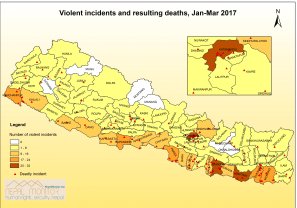Analysis
Trends in Violence and Contestation in Nepal – First Quarterly Report
2017-05-02

This is the first in a series of quarterly reports from Nepal Peace Monitoring Project (PMP), a new initiative by COCAP|NepalMonitor.org. The PMP uses a methodology similar to Nepalmonitor.org’s alert and mapping system, with a more exclusive focus of gathering information on violence and contestation. The PMP’s goal is to improve our understanding of violence in Nepal to better respond to it and promote peace.
Summary:
From January to March 2017, the PMP recorded the following:
- The most common drivers of deadly violence were gender-based violence (GBV) (35 deaths, or 28 percent of all violent deaths) and personal disputes (31 deaths or 25 percent). While political contestation caused less fatalities (six deaths including five in a police shooting in Maleth, Saptari), it was the second largest driver of violent incidents this quarter, with 94 cases that resulted in 100 injuries. Half of these incidents of political violence happened after the announcement of local elections and consisted mainly of clashes, vandalism and arson.
- The most common drivers of non-violent contestation were political issues, such as local body restructuring in January, elections to Free Student Union in February, and the upcoming local elections in March; and governance issues, such as calls for legal action or protests against unfair treatment by authorities.
- 35 women were killed, 29 injured and 104 sexually assaulted as a result of gender-based violence, a leading cause of violent deaths and violent incidents (154 incidents, or 31 percent of all violent incidents this quarter). 42 percent of all victims of deadly violence in Nepal, and all of those sexually assaulted recorded in this quarter, were women; of those, respectively 55 percent and 85 percent were under the age of 26 years. Despite legislation that outlaws allegations of witchcraft, there were six cases this quarter that resulted in women being mistreated or beaten by family or community members. In one case the beating led to the victim having a miscarriage.

